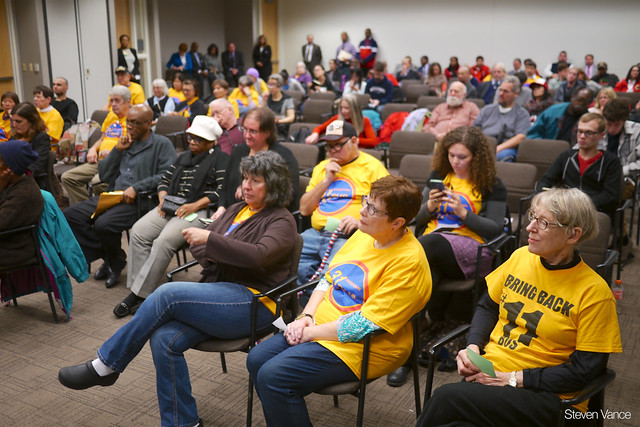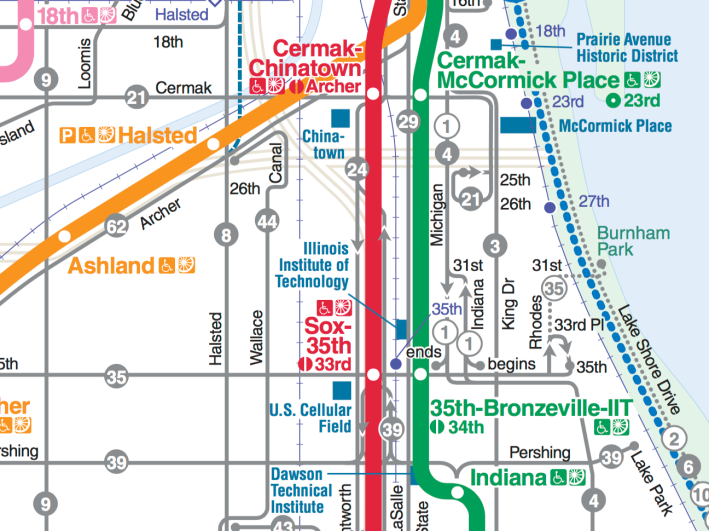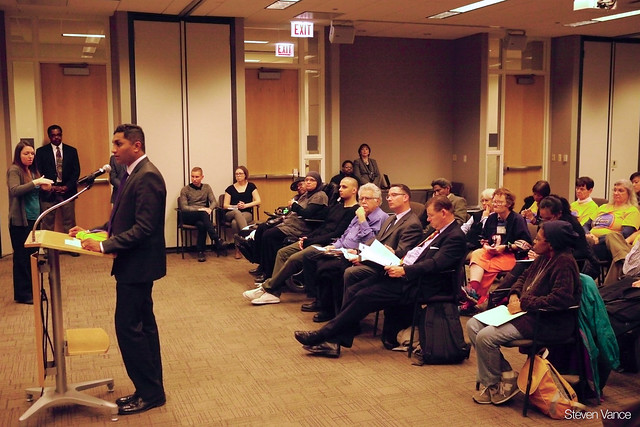
During the public comment period of last night's Chicago Transit Authority's budget hearing, the only one the agency is holding this year, many politicians and residents urged the CTA board to restore the Lincoln Avenue and 31st Street bus routes.
The hearing opened with budget director Tom McKone providing an overview of the 2016 spending plan. It maintains virtually all current bus service and brings back the old express bus routes on Ashland Avenue and Western Avenue. As a strategy to avoid a fare hike, the budget includes layoffs for some management staff, plus eliminating some vacant positions.
When the floor was opened for comments, Ald. Michele Smith (43rd) said she was once again there to "respectfully request" that the board find a place in the budget to restore the full #11 Lincoln bus route. In 2012, as part of several bus line cuts to help fund the CTA's "de-crowding plan" for additional train service, the agency cancelled bus service on Lincoln between the Brown Line's Western stop and the Fullerton station. Smith said the strategy hasn't been a success.
Smith noted that her Lincoln Park ward includes many college students, young professionals, and seniors – the most common demographics for frequent transit users, both locally and nationally, she said. Smith added new developments, including the redevelopment of the former Children's Memorial Hospital site at Fullerton/Halsted/Lincoln, will bring over 1,000 new residences and over 150,000 square feet of retail to the Lincoln Avenue corridor.
Ald. Ameya Pawar (47th), who has been leading the charge to restore the #11 ever since service was cut, was more somber when he addressed the board. Pawar said he wants his ward to include affordable neighborhoods where people can age in place. He added that, despite the increased capacity on the Brown Line, the elimination of Lincoln service makes it harder for many of his constituents to get to destinations within the ward.
One North Side resident testified that the Brown Line is often too crowded to be a satisfactory replacement for the Lincoln bus. Another asked that the existing #11 route be extended north from Fullerton to at least Belmont Avenue, so that she could access a nearby Jewel-Osco.
Bridgeport's Ald. Patrick Thompson (11th), elected this year, spoke up in favor of restoring the #31 bus, which was cut in 1997. "A lot has changed in our community" since then, Thompson said, noting that there has been a new wave of development in recent years and better transit could help reduce congestion. He proposed a bus route that would serve the 31st/Ashland Orange Line station and the Sox/35th Red Line stop, ending at 31st Street beach.
Thompson added that his predecessor James Balcer called for restoring the #31, and there is also support from City Council members George Cardenas (12th), Will Burns (4th), and Pat Dowell (3rd). The CTA piloted a version of the 31st Street bus for two six-month periods in 2012 and 2013 by extending the 35th Street bus up to 31st Street in Little Village via Kedzie Avenue.
Debbie Liu, a community organizer with the Coalition for a Better Chinese American Community, echoed Thompson's statement that the transportation needs of the Near South Side have changed in recent years. She said that many seniors in "Greater Chinatown," including parts of Bridgeport, Armor Square, and the South Loop, don't have access to east-west transit routes, so they often have to rely on rides from family members in order to leave the house.
There are currently no east-west bus lines east of Ashland Avenue in the 1.5-mile stretch between Cermak Road and 35th, an unusually long service gap. "Restoring the 31 is providing transportation to the most vulnerable," Liu concluded.

Despite the passionate pleas from politicians and residents, it's unlikely that the Lincoln or 31st Street buses will be restored next year. The board votes to approve the 2016 budget tomorrow, which leaves little time to deliberate and ask CTA staff to rejigger the spending plan.
Moreover, the CTA's plan to avoid new service cuts and fare hikes next year may not be realistic. At the hearing, the Civic Federation's Laurence Msall and the Active Transportation Alliance's Kyle Whitehead noted that that the 2016 budget assumes that Illinois Governor Bruce Rauner won't follow through with his plan to cut $170 million in state funding for the Regional Transit Authority. That would mean an estimated $130 million in cuts to the CTA.
Msall called it "overly optimistic" for the CTA to rely on this state money. Whitehead raised the specter of what the agency would have to do to make up for a $130 million shortfall. He noted that, in order to save roughly $100 million as part of the 2012 de-crowding plan, the agency laid off 1,000 workers and cut or shortened dozens of bus routes.
![]()
Did you appreciate this post? Streetsblog Chicago is currently funded until April 2016. Consider making a donation through our PublicGood site to help ensure we can continue to publish next year.





